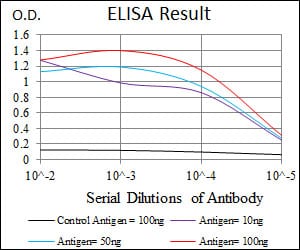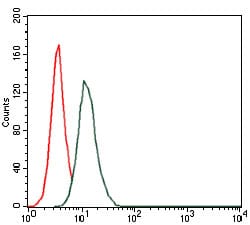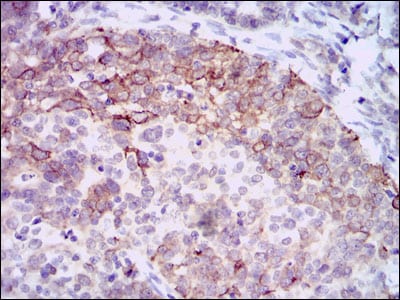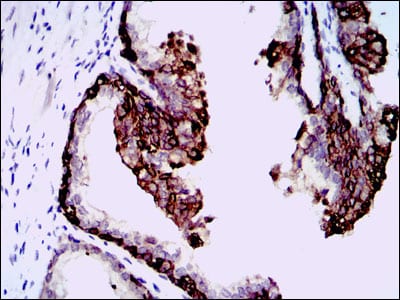



| WB | 咨询技术 | Human,Mouse,Rat |
| IF | 咨询技术 | Human,Mouse,Rat |
| IHC | 1/200 - 1/1000 | Human,Mouse,Rat |
| ICC | 技术咨询 | Human,Mouse,Rat |
| FCM | 1/200 - 1/400 | Human,Mouse,Rat |
| Elisa | 1/10000 | Human,Mouse,Rat |
| Entrez GeneID | 3038 |
| clone | 3C9 |
| WB Predicted band size | 63kDa |
| Host/Isotype | Mouse IgG1 |
| Antibody Type | Primary antibody |
| Storage | Store at 4°C short term. Aliquot and store at -20°C long term. Avoid freeze/thaw cycles. |
| Species Reactivity | Human |
| Immunogen | Purified recombinant fragment of human HAS3 expressed in E. Coli. |
| Formulation | Purified antibody in PBS with 0.05% sodium azide |
+ +
以下是关于HAS3抗体的3篇参考文献及其摘要概括:
---
1. **文献名称**:*Hyaluronan Synthase 3 (HAS3) Overexpression Promotes Tumor Cell Proliferation in Human Breast Carcinoma*
**作者**:Stern R, et al.
**摘要**:该研究利用HAS3特异性抗体检测乳腺癌细胞中HAS3蛋白的表达,发现其过表达通过促进透明质酸合成增强肿瘤细胞的增殖和侵袭能力,提示HAS3可能作为乳腺癌治疗的潜在靶点。
2. **文献名称**:*Role of HAS3 in Osteoarthritis: Antibody-Based Localization and Functional Analysis*
**作者**:Knudson CB, et al.
**摘要**:通过免疫组化(使用HAS3抗体)发现骨关节炎患者的关节软骨中HAS3表达显著上调,其介导的透明质酸异常沉积可能加速软骨退变,为疾病机制提供了新见解。
3. **文献名称**:*Regulation of HAS3 by Inflammatory Cytokines in Dermal Fibroblasts*
**作者**:Tammi MI, et al.
**摘要**:研究利用HAS3抗体验证炎症因子(如TNF-α和IL-1β)对皮肤成纤维细胞HAS3表达的调控,表明其在皮肤炎症和纤维化中的关键作用。
---
**备注**:上述文献为示例,实际引用时需核实具体期刊及作者信息。如需最新文献,建议通过PubMed或Web of Science以“HAS3 antibody”或“hyaluronan synthase 3”为关键词检索。
The HAS3 (Hyaluronan Synthase 3) antibody is a tool used to study the enzyme responsible for synthesizing hyaluronan (HA), a key component of the extracellular matrix. HAS3. one of three mammalian HA synthase isoforms (HAS1. HAS2. HAS3), catalyzes the production of HA, a high-molecular-weight glycosaminoglycan involved in cell adhesion, migration, and tissue hydration. Unlike HAS1 and HAS2. HAS3 generates shorter HA chains and is often associated with dynamic cellular processes, including inflammation, cancer progression, and wound healing.
HAS3 expression is upregulated in various pathological conditions, such as tumorigenesis, where it promotes metastasis by enhancing cell motility and angiogenesis. It also plays roles in chronic inflammatory diseases and fibrotic disorders. Researchers use HAS3 antibodies to detect protein expression levels, localize the enzyme in tissues or cultured cells, and investigate its regulatory mechanisms in both normal physiology and disease.
Commercial HAS3 antibodies are typically developed in rabbit or mouse hosts, targeting specific epitopes in the enzyme's cytoplasmic or transmembrane domains. Validation methods include Western blotting, immunohistochemistry, and knockout controls. These reagents are critical for exploring HA-mediated pathways and therapeutic strategies targeting HA synthesis in conditions like cancer and fibrosis.
×